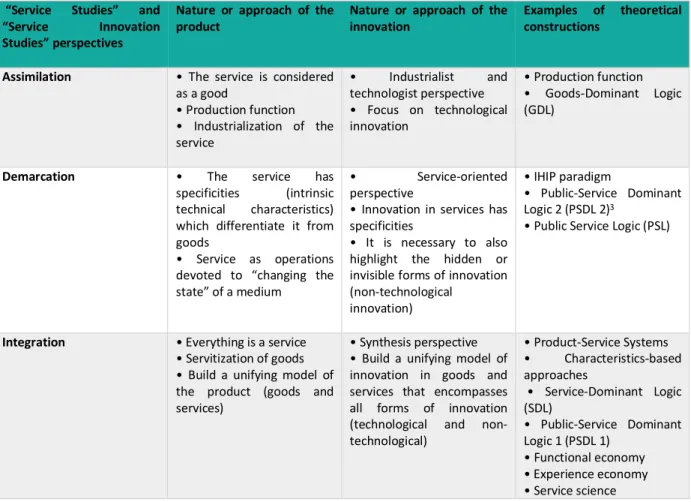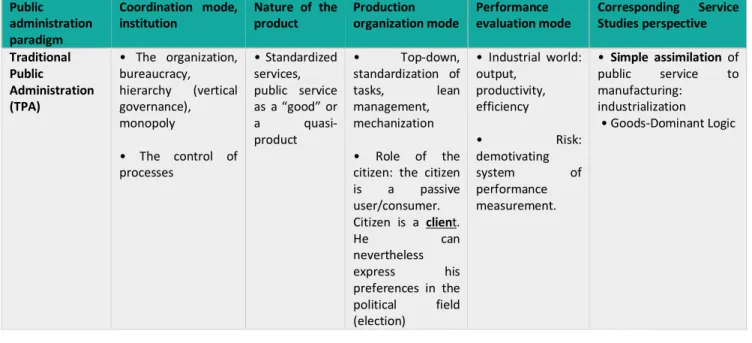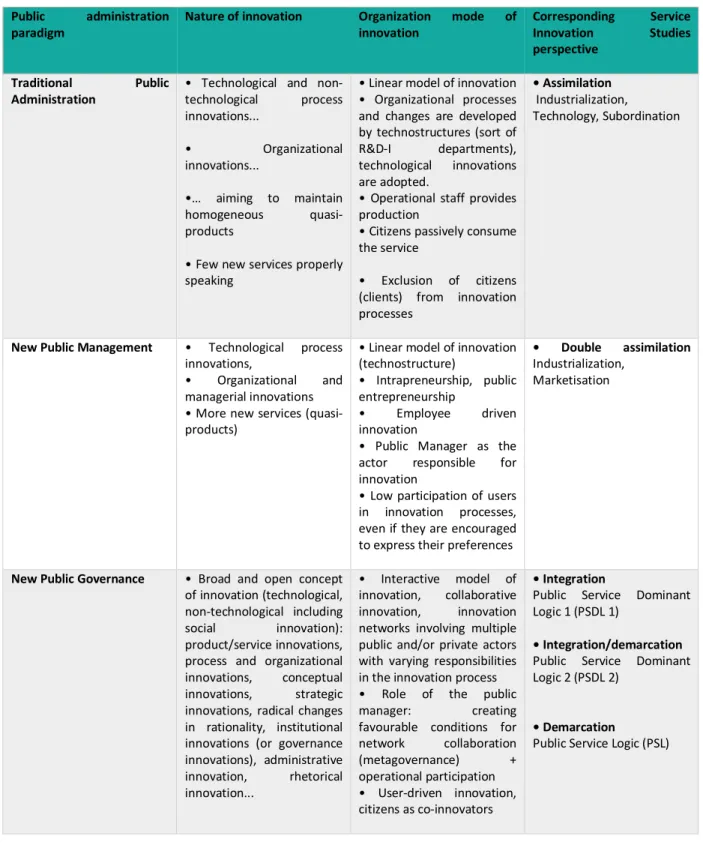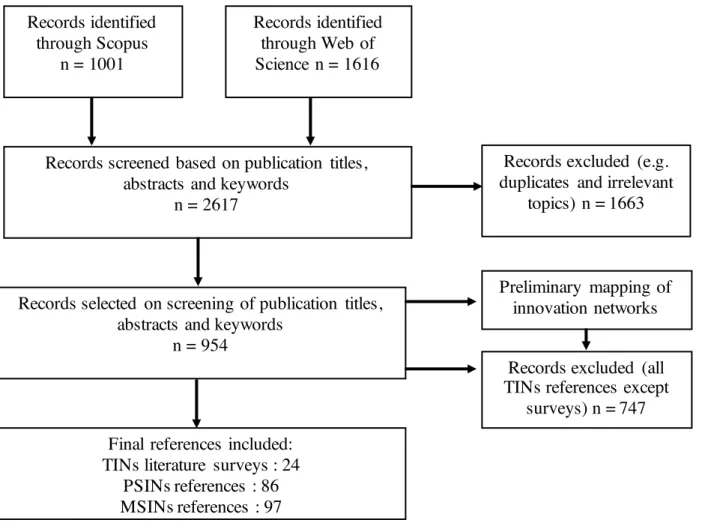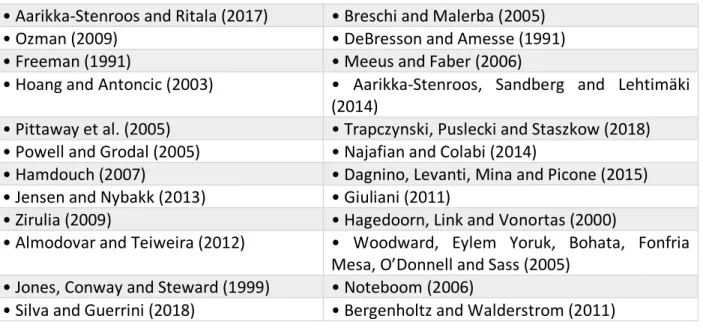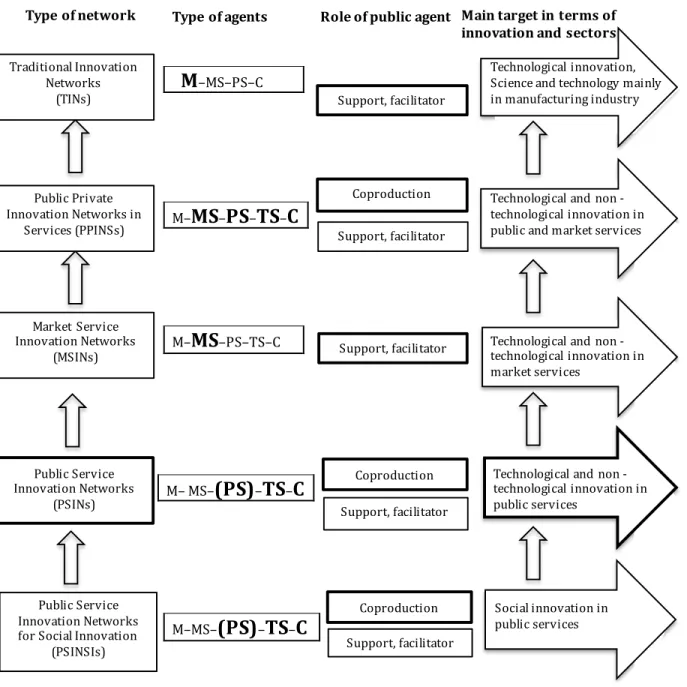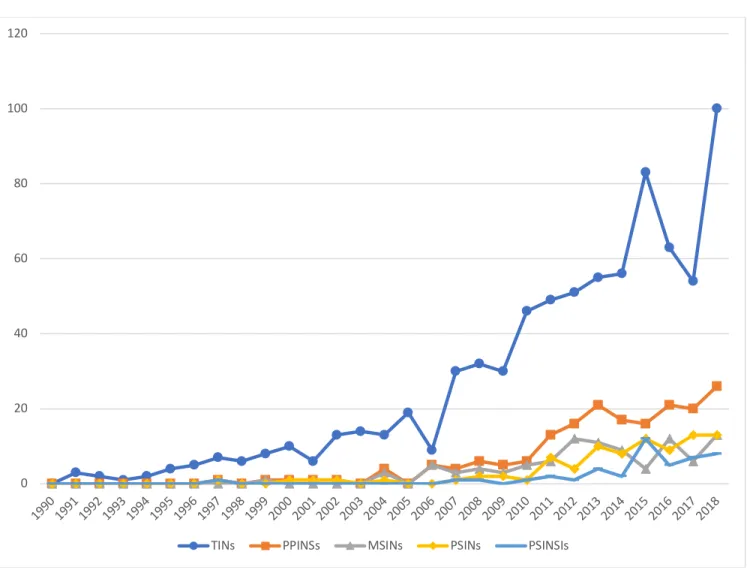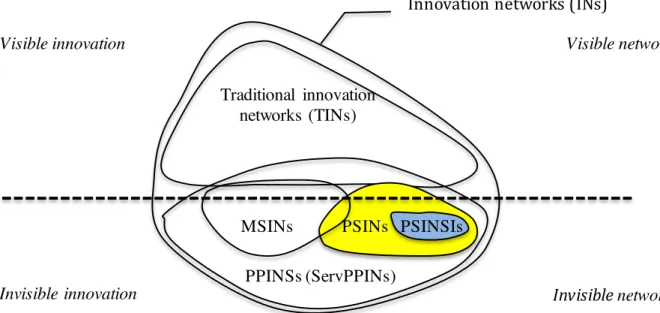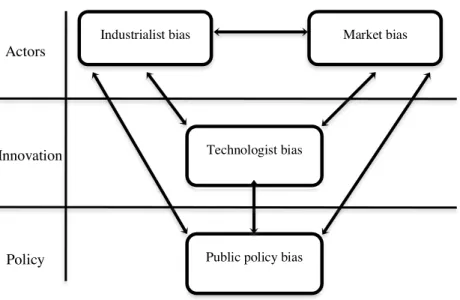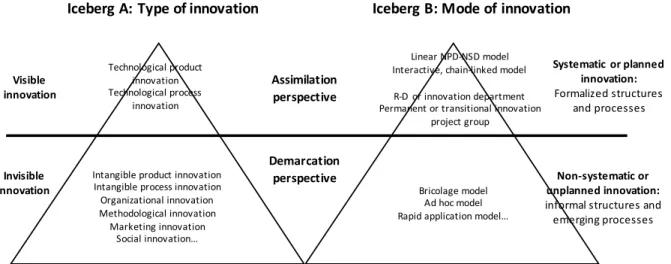HAL Id: halshs-02445373
https://halshs.archives-ouvertes.fr/halshs-02445373
Submitted on 20 Jan 2020HAL is a multi-disciplinary open access archive for the deposit and dissemination of sci-entific research documents, whether they are pub-lished or not. The documents may come from teaching and research institutions in France or abroad, or from public or private research centers.
L’archive ouverte pluridisciplinaire HAL, est destinée au dépôt et à la diffusion de documents scientifiques de niveau recherche, publiés ou non, émanant des établissements d’enseignement et de recherche français ou étrangers, des laboratoires publics ou privés.
Collaborating for Innovation and Value Creation
Benoît Desmarchelier, Faridah Djellal, Faïz Gallouj
To cite this version:
Benoît Desmarchelier, Faridah Djellal, Faïz Gallouj. Public Service Innovation Networks (PSINs): Collaborating for Innovation and Value Creation: Co-VAL EU funded project [770356] ”Understanding value co-creation in public services for transforming European public administrations”. [Research Report] University of Lille; European Commision. 2019. �halshs-02445373�
H2020-SC6-CULT-COOP-2016-2017
CULT-COOP-11-2016-2017
Co-VAL [770356] “Understanding value co-creation in public services for transforming
European public administrations”
Project Reference No Co-VAL [770356]
Workpackage WP6: Structural transformations: public-private innovation networks and social innovation in public services
Dissemination Level Open
Date 14/10/2019
Author(s) Benoît Desmarchelier, Faridah Djellal and Faïz Gallouj, University of Lille
Document description
This deliverable is given over to “Public Service Innovation Networks” (PSINs). It seeks to define and characterize PSINs, from a structural point of view (sectors, actors, interaction, innovation) and a dynamic point of view (emergence, functioning, life cycle, performance) and to understand what distinguishes them from other types of innovation networks.
D 6.1.1 Public Service Innovation Networks (PSINs):
Collaborating for Innovation and Value Creation
Executive summary:
Introduction
This report is given over to a particular organizational structure which we denote by the term “Public Service Innovation Network” (PSIN). PSINs are multi-agent collaborative arrangements that bring into play a variable number of public and private agents, especially citizens, in order to co-produce technological and non-technological innovations and ultimately co-create value, in the field of public
services (sectoral perspective) or public service (functional perspective).
This report has three main objectives.
The first objective is to establish a dialogue between “service studies” and “public management studies”, by examining how the innovation issue fits into the different paradigms of public administration (namely Traditional Public Administration, New Public Management and New Public Governance), and how these different paradigms can be linked to the different analytical perspectives generally used in “Service Innovation Studies” to understand innovation (namely assimilation, demarcation and integration).
The second objective is to provide an original mapping of innovation networks, in the context of the service economy, and to account for the tertiarization of this concept, i.e. for the rise of market and non-market services in innovation networks.
The third objective is to provide a more in-depth analysis of PSINs, from a structural and a dynamic point of view and to understand what distinguishes them from other innovation networks, in particular traditional innovation networks (TINs) and public-private innovation networks in services (PPINSs).
Method
This report is mainly based on a survey of the literature using SCOPUS and Web of Science databases, and the PRISMA method (Preferred Reporting Items for Systematic Reviews and Meta Analyses). We used the following search stream: [“innovation network” OR “innovation collaboration” OR “innovation cooperation” OR “innovation partnership”]. The search was limited to articles, books and book chapters published in English over the period 1990-2018.
Findings
First objective
In the traditional public administration paradigm, the reference is not services, but goods. The purpose is to produce homogeneous quasi-products, by using technical systems and rationalizing production processes. This paradigm falls within the scope of an (industrialist) assimilation perspective. In the new public management paradigm, it is still not the service as such which is the reference, but the market good. Production processes as well as innovation processes do not fall within the scope of a demarcation perspective, but still of an (industrial and market) assimilation
perspective. Finally, in the new public governance paradigm, the reference is the service. “Public service studies” here are explicitly based on service theory, in particular Service-Dominant Logic (SDL). They first fall within the scope of an integrative perspective, and secondly within the scope of a demarcation perspective emphasizing the specificities of public services vis-à-vis general SDL. In both cases, the reference to service theory introduces a broad and open concept of innovation that covers technological aspects as well as a wide variety of non-technological aspects of innovation. It also introduces an interactive and open concept of the dynamics of production and innovation, centred on multi-agent networks, in which the user/citizen occupies or is urged to occupy an essential place as co-producer, co-innovator and ultimately co-creator of value.
Second objective
Our survey of the literature made it possible to identify 5 types of innovation networks, namely: Traditional Innovation Networks (TINs), Public Private Innovation Networks in Services (PPINSs), Market Services Innovation Networks (MSINs), Public Service Innovation Networks (PSINs) and Public Service Innovation Networks for Social Innovation (PSINSIs) that reflect the tertiarization of the innovation network concept. These networks types can be distinguished according to following criteria: the types of agents involved in the network, the role played by the public agent, the nature of the targeted innovation and the main sector concerned by the innovation in question. TINs are networks that focus on the manufacturing industry and technological innovation and in which the public administration is not a co-producer of innovation, but a facilitator. PPINSs, that were the subject of the European ServPPIN project are systems of service-oriented collaborations, public-private collaborations, open to non-technological innovation. MSINs are innovation networks focused on market services and service innovation. PSINs focus on innovation in public services. The main actors in this type of network are citizens, public sector and third sector organizations. Finally, PSINSIs are a special subcategory of PSINs dedicated to social innovation.
The different types of networks envisaged can be characterized by their degree of visibility, that is to say, their level of recognition by economic analysis. Over the last 30 years, the concept of (traditional) innovation network based on manufacturing industry, especially high-tech R-D intensive industry, has been quite successful and has given rise to a great deal of literature that is exponentially increasing. The extension of innovation networks to services and service innovation has attracted attention from researchers more recently, whatever the type of network considered (PPINs, MSINs, PSINs, PSINSIs). The emergence of the literature on these new types of tertiarized networks can be dated back to the mid-2000s. The literature on PSINs and PSINSIs is the least extensive. It is still in its “infancy”.
These different types of innovation networks are not independent of each other. There is an intersection between TINs and PPINSs. This intersection equates to certain PPINSs which are focused on technological innovation. PSINSIs are a sub-category of PSINs whose target is social innovation in public services. These two forms of innovation networks (PSINs and PSINSIs) are themselves sub-categories of PPINSs.
Third objective
We have tried to define and characterize PSINs, by examining, first of all, a number of structural
variables: the nature of the actors involved and their interactions, and the forms and modalities of the
can be based on the following criteria: 1) the (sectoral or functional) fields where networks are set up; 2) the type of actors involved; 3) the nature of the innovation provided by the network. A typology of PSINs based on the nature of the actors involved in the network would include the following categories: (1) Networks made up of both public and private agents, (2) Networks consisting only of public agents belonging to different public organizations., (3) Networks consisting only of private agents, working collectively to co-produce an innovation that falls within the scope of public service, not in its sectoral sense but in its functional sense (i.e. services of general interest). The nature of innovation can provide the basis for a fairly simple typology of PSINs that distinguishes: (1) Networks created for social innovation in public services. This is what we call PSINSIs. (2) Networks created for other forms of public service innovations (i.e. non-social public service innovations).
We then shifted the analysis towards dynamic variables, describing the modes of emergence and functioning of the networks, and their integration in time and in space. The question of network formation distinguishes planned networks from spontaneous networks. Planned or engineered PSINs are established under the impetus of an initiating agent that will invite other potential members to join the network. In theory, the initiator of the network may be any agent. In reality, however, it seems that in PSINs, the initiating agent is very often the public administration itself. The situation is different for planned PSINSIs which are most often initiated by private agents (citizens, associations and so on). Spontaneous or emerging PSINs emerge in a self-organized way because of the convergence of the activities of agents facing a given problem, in a given context (a district, a city, a region, etc.). Here again, although, in theory, the spontaneous emergence may involve any agent, the
spontaneous (self-organized) networks more often involve citizens (and not government). The
spontaneous emergence of this type of network can be explained by the lack of public solutions to a given social problem or the ineffectiveness of the existing solutions.
The modes of formation of PSINs lead to a (simplified) distinction between two opposite modes of
functioning: (1) a vertical or top-down mode of functioning, in which, after the network is established,
the initiating agent continues to enjoy a privileged “hierarchical” position: it is the conductor. (2) a horizontal or bottom-up mode of functioning, which favours local interactions and in which responsibilities and leadership are more shared.
PSINs and especially PSINSIs are initially local innovation networks. They organize collaborations on a municipality, neighbourhood or other small scale. This geographical characteristic is of course closely linked to the nature of the innovation that is carried out by the network and the way it is produced (innovation that aims to solve concrete social problems in the immediate living environment of individuals, innovation that involves the people concerned by the problem in the collaboration). However, there appear to be differences in spatial constraints depending on the type of PSIN considered. After all, spontaneous PSINs are more likely to be proximity networks than planned PSINs. Planned PSINs, especially when they are planned by public agents, are less subject to geographical constraints. Depending on the nature of the problem to be solved, the public agent may invite agents located anywhere throughout the national territory or even from abroad. Furthermore, some complex problems can neither be solved by a single actor nor on a single geographical scale (in this case a local scale). These are problems that, even if they manifest locally, arise in regional, national or international terms. This applies, for example, to migrant and refugee issues or environmental issues.
The ultimate goal of PSINs being the co-creation of value, we finally introduced a typology of the worlds of value, which makes it possible to consider a plurality of performance principles at work in PSINs: industrial and technical performance, market and financial performance, domestic or relational performance, social-civic performance, reputational performance and innovation performance. These different concepts of value and corresponding performance are not, of course, independent of each other. They can complement and reinforce or compete and conflict with each other (in the latter case, the creation of one form of value leads to the destruction of another form).
Implications
PSINs constitute an important socio-economic issue now acknowledged by the public authorities at the national and European level. Although PSINs are increasingly taken seriously in contemporary economies, efforts are nevertheless needed to theoretically reinforce this concept.
On the theoretical level, efforts are needed to theoretically reinforce our knowledge of the modes of formation and functioning of these networks. After all, the literature is dominated by case studies and by a concept of PSINs (in particular when they focus on social innovations) as temporary curative arrangements (aimed at overcoming the temporary failure of public services). One way to reinforce the theoretical basis of PSINs might be, not only to analyse them autonomously, but to explicitly include them in the mapping and discussion of innovation systems, whether local, regional, national, social or sectoral.
On the methodological level, a reverse shift from theoretical to empirical focus is required. After all, beyond the theoretical considerations on the plurality of forms of performance that we have outlined in this work, it is necessary to define and build concrete tools for properly measuring PSINs results and performance.
Finally, on the political level, it is necessary to envisage public policies (in particular vertical or specific ones) that would help support the formation, functioning and performance of these networks, by taking into account the diversity of forms of PSINs that we have highlighted in this research.
Table of contents
Introduction ...9
1 Innovation in public services in the light of public administration paradigms and service innovation perspectives ...12
1.1 The three analytical perspectives for addressing “Service Studies” in general and “Service Innovation Studies” in particular ... 13
1.1.1 The ADI framework and the product definition ... 14
1.1.2 The ADI framework and innovation ... 17
1.2 The three paradigms of public administration and the product ... 18
1.2.1 Traditional public administration and product ... 19
1.2.2 New public management and product... 20
1.2.3 New public governance and product ... 21
1.3 Public administration paradigms and innovation ... 22
1.3.1 TPA and innovation ... 24
1.3.2 NPM and innovation ... 24
1.3.3 NPG and innovation ... 25
1.3.3.1 The nature of innovation ... 25
1.3.3.2 The organizational modes of innovation: the rise of innovation networks in public services ... 25
2 Varieties of innovation networks: towards a tertiarization/servitization of the concept ...28
2.1 A General Description of the Different Expressions of Innovation networks: TINs, PPINSs, MSINs, PSINs and PSINSIs... 29
2.1.1 Methodology ... 29
2.1.2 The Different Forms of Networks from a Morphological and Functional Point of View ... 31
2.1.3 The Visibility of the Different Types of Networks and the Relationships among them ... 33
2.2 Traditional Innovation Networks (TINs)... 35
2.3 Public-Private Innovation Networks in Services (PPINSs) ... 38
2.4 Market Service Innovation Networks (MSINs) ... 40
3 PSINS at the heart of collaborative innovation in public services ...43
3.1 PSINs through morphological/structural variables ... 43
3.1.1 PSINs according to the fields where they are set up ... 44
3.1.2 PSINs according to the type of actors Involved ... 45
3.1.2.1 The nature of the actors ... 45
3.1.2.2 The role of citizens ... 46
3.1.2.3 The number of actors ... 46
3.1.2.4 The importance, influence and power of the actors ... 47
3.1.2.5 A typology of PSINs according to the Type of Actors Involved ... 47
3.1.3 Interactions between actors ... 49
3.1.3.1 The nature of the interaction ... 49
3.1.3.2 The intensity of the interaction ... 51
3.1.3.3 The number of interactions and network density ... 52
3.1.3.4 The instruments of interaction ... 52
3.1.4 Innovation in the network ... 53
3.1.4.1 The nature (type) of innovation ... 53
3.1.4.2 The innovation process: a non-linear or open innovation model ... 54
3.1.4.3 Appropriation of the results of an innovation resulting from a collaborative process ... 55
3.2.2 The functioning mode of the network ... 57
3.2.2.1 Management and governance of PSINs ... 57
3.2.2.2 Obstacles to the functioning of innovation networks and the linkage of institutional logics... 60
3.2.3 The integration of the network in the time frame (its life cycle) ... 61
3.2.4 The integration of the network in space (the geography of PSINs) ... 63
3.2.5 Assessing network performance... 64
3.2.5.1 The worlds of value ... 64
3.2.5.2 From the various worlds of value to the various concepts of performance ... 65
3.2.5.3 Interactions between different worlds of value/performance ... 66
Conclusion ...68
Bibliography ...70
List of Figures
Figure 1: Diagram of the search strategy and the selection process ... 30Figure 2: Different types of innovation networks: TINs, PPINSs, MSINs, PSINs, PSINSIs ... 32
Figure 3: Number of annual publications according to types of innovation networks ... 34
Figure 4: The innovation network iceberg ... 35
Figure 5: The biases characterizing TINs ... 36
Figure 6: The service innovation icebergs ... 40
Figure 7: A typology of PSINs based on the type of actors ... 48
Figure 8: Formation of a spontaneous network and a planned network ... 56
Figure 9: Modes of formation and modes of functioning of PSINs ... 59
Figure 10: The life cycle of spontaneous and planned innovation networks ... 62
Figure 11: The different dimensions of public value and their interactions ... 66
List of tables
Table 1: The ADI analytical framework in Service Studies and Service Innovation Studies ... 17Table 2: The three paradigms of public administration and the corresponding service studies perspectives... 18
Table 3: Public administration paradigms, innovation and the theoretical perspectives of Service Innovation Studies ... 23
Table 4: Surveys of the literature on traditional innovation networks ... 31
Table 5: Types of logic multiplicity within organizations ... 61
List of Terms and Abbreviations
Abbreviation Definition
PSIN Public Service(s) Innovation Network
MSIN Market Services Innovation Network
TIN Traditional Innovation Network
PPINS Public Private Innovation Network in Services
IS Innovation Studies
SIS Service Innovation Studies
TPA Traditional Public Administration
NPM New Public Management
NPG New Public Governance
ADI Assimilation, Demarcation, Integration
GDL Goods-Dominant Logic
SDL Service-Dominant Logic
PSDL Public Service-Dominant Logic
PSL Public Service Logic
MI Manufacturing Industry
PS Public Services
MS Market Services
TS Third Sector
C Citizen
SNA Social Network Analysis
IHIP Intangibility, Heterogeneity, Inseparability, Perishability
IN Innovation Network
Public Service Innovation Networks (PSINs): Collaborating
for Innovation and Value Creation
Benoît Desmarchelier, Faridah Djellal and Faïz Gallouj
Clersé-CNRS, University of Lille
Introduction
In contemporary economies, innovation is a universal and ubiquitous phenomenon present in every economic sector and every sphere of social life. However, whatever the discipline considered (economics, management, sociology, political science and so on), our analytical and conceptual tools have often been unable to grasp this innovation dynamic in its full magnitude. Thus, entire sectors of our economies (in particular, the service sectors, including non-market services) and essential forms of innovation (non-technological innovations, including social innovations) have long remained marginal in the field of “Innovation Studies”. This innovation or measurement gap may largely be explained by the inertia of our conceptual tools designed in and for manufacturing economies. It reflects, after all, invisible or hidden innovations (NESTA, 2007), which do not fall within the traditional industrial and market indicators such as R&D, patents, and material technologies.
Considerable efforts have been made in recent years to bridge this innovation gap (recognition and measurement gap), taking into account both hidden forms of innovation and forgotten sectors. Thus, a field of “Service Innovation Studies” has enriched the traditional field of “Innovation Studies” that focuses on technological and industrial innovation (Gallouj and Djellal, 2015, 2018; Djellal and Gallouj, 2018). An additional step forward in reducing the innovation gap has been achieved by taking into account the innovation dynamics and the dynamic capabilities in public services (Moore and Hartley, 2008; Windrum and Koch, 2008; Djellal et al., 2013; De Vries et al. 2015; Osborne and Brown, 2013; Miles, 2013; Potts and Kastelle, 2010; Fuglsang and Sundbo, 2016; Fuglsang et al., 2014; Piening, 2013; Jordan, 2014; Arundel et al., 2019; Desmarchelier, Djellal and Gallouj, 2019; Gieske, Duijn, and van Buuren, 2019).
Ben Martin (2015) considers this gradual opening (to services and service innovation) of the field of innovation as one of the twenty main challenges in “Innovation Studies”, since their advent, nearly a half-century ago. Djellal and Gallouj (2018) for their part consider this opening as one of the fifteen main advances in “Service Innovation Studies”, since their advent, nearly a quarter century ago. It is also described as “the shift from visible innovation to invisible innovation”. It is parallel to another
fundamental evolution in “Innovation Studies” which is the shift from a linear and closed model of innovation to an interactive and open or network model (Martin, 2015).
This rise of services, of service innovation and of the networked organization of innovation also lies at the heart of the shifts in public administration paradigms (Osborne, 2006, 2010). Indeed, in the
traditional public administration paradigm, innovation is, for the most part, associated with the
industrial rationalization of production processes and the adoption of technical systems, the aim being to provide passive citizens with homogeneous quasi-products. This innovation activity, which excludes the user, is organized in a linear and top-down way. In the new public management
paradigm, the industrialist perspective remains dominant, and innovation continues to be organized
in a linear (non-interactive) way. The main novelty compared to the previous paradigm is the introduction of market management techniques in public services. The new public governance
paradigm, currently at work in all developed countries, fundamentally changes the perspective of
innovation. Indeed, this new paradigm considers public services as services and not as goods, and thus allows a broad and open concept of innovation integrating both technological and non-technological dimensions (new services, new processes, new organizations…). From the point of view of the organization of innovation, this paradigm emphasizes the collaborative dimension, and in particular the participation of citizens in innovation networks (Osborne, 2006, 2010; Voorberg et al., 2015; Mergel, 2018; Crosby et al., 2017; Torfing, 2019). The importance given to networks, whether they be production or innovation networks, also leads to designating this new paradigm as a paradigm of “Networked Governance” (Kelly et al., 2002).
The purpose of this research is, first, to discuss how these different paradigms can be linked to the different analytical perspectives generally used in “Service Innovation Studies” to understand innovation. The purpose is in particular to show how the evolutions of these paradigms and perspectives are reflected, regarding the nature of innovation, by a shift towards a broad and open concept of innovation (including non-technological innovation) and, regarding its mode of organization, by a shift from a linear model of public service innovation to an interactive or collaborative model, in which citizens occupy a central place in the process of innovation and in value co-creation. This model of collaborative or networked innovation is well known and documented in some public services such as health (Djellal and Gallouj, 2007). But, although this is neglected by literature, it tends to diffuse to all services offered by public administration and to the design of some public reforms as well. This networked model seems to be particularly appropriate in the case of public services whose purpose is to solve, through social innovation, thorny social problems, including problems related to elder care, school dropout, migrants or refugees, environment, etc.
This research is organized into three sections.
In the first section, we address the issue of innovation in public services through the prism of the three main paradigms of public administration (i.e. traditional public administration, new public management and new public governance), and of the three main analytical perspectives that structure Service Studies (i.e. assimilation, demarcation and integration). We analyse how the shifts in these paradigms and perspectives converge to highlight, on the one hand, a broad and open concept of innovation (including non-technological innovation) and, on the other hand, interactive and network innovation models.
In the second section, we discuss the concept of innovation networks and the place that is given to services and especially (public) services in them. In other words, this section is dedicated to a consideration of the tertiarization of innovation networks. Its purpose is not to develop a conceptual framework or a new theory, but to provide an original mapping of the innovation network concept, in the context of the service economy. The aim is to show how, in parallel with the shift from visible innovation to invisible innovation, services in general and public services in particular are gradually moving from a peripheral to a central position in the innovation networks. Based on a review of the literature, we discuss how traditional innovation networks can be enriched by other types of networks more focused on services and public services, namely Public-Private Innovation Networks in Services (PPINSs), Market Service Innovation Networks (MSINs), Public Service Innovation Networks (PSINs) and Public Service Innovation Networks for Social Innovation (PSINSIs).
The tertiarization of the innovation network concept which is addressed in this second section encompasses both market services and public services. While the definition of market service does not pose much problem, the term “public” in its various uses (public sector, public administration, public agent/actor...) and in its relationships with innovation (public sector innovation, public service innovation, public innovation...) deserves some clarifications. According to Flynn (2007, p. 2), the
public sector is “those parts of the economy that are either in state ownership or under contract to
the state, plus those parts that are regulated or subsidized in the public context”. The public sector is composed of public agents/actors that consist in both public organizations (including governmental bodies, healthcare and education organizations...) and public enterprises. Public service is the service (i.e. a set of use values) which is delivered not only by entities belonging to the public sector, but also to the private sector (for example, NGOs). Public service is therefore somehow synonymous with “service of general interest”. When the focus is on innovation associated with these different terms,
public service innovation or public innovation can be said to go beyond the boundaries of public sector innovation, since it also includes the innovation developed within networks where the main actors are
citizens and not-for-profit organizations.
Finally, the third section is given over to a more in-depth analysis of PSINs and PSINSIs, which are the main focus of this research. PSINs (and among them PSINSIs), which are very successful within the “new public governance paradigm”, are multi-agent collaborative arrangements that develop within
public services (sectoral perspective) or public service (functional perspective), spontaneously or at
the instigation of local, national or European public policies. They bring into play a variable number of public and private agents, especially citizens, in order to co-produce innovations and ultimately contribute to value co-creation. In the third section, our goal is to deepen the definition and description of PSINs, especially in comparison with the other network forms evoked in section 2, namely TINs, PPINSs and MSINs and to examine in particular how PSINs are formed and function in order to co-create, more or less efficiently, value in public service(s), through innovation.
1 Innovation in public services in the light of public administration
paradigms and service innovation perspectives
Public services have long remained the Cinderella of “Innovation Studies”, the predominant idea being that innovation is peculiar to market sectors and that the term “public innovation” is an oxymoron (Sørensen and Torfing, 2013). However, this observation is not relevant to all public services. After all, as we have already pointed out, it is not disputed, for example, that in our modern economies, public health services are among the most innovative activities or that innovation is consubstantially linked to public research services and to universities. Other exceptions include, for example, public broadcasting services and security and defence services (Nicolaÿ, 2017; Nicolaÿ and Lenfle, 2019). Nevertheless, the vast majority of other public services, and in particular administrative public services, have long been considered as hermetically closed to innovation. The literature has provided many explanations for this lack of real or perceived innovativeness, including the lack of competition and the monopoly nature of public services, the fact that the services are provided free of charge, the lack of resources, the Weberian argument of rigidity and inertia of bureaucracies, the difficulty of changing the statutory rights of civil servants, the risk-adverse character of politicians at the head of public administrations whose primary concern is re-election and the nature of the appropriation regimes (Halvorsen et al., 2005; Borins, 2001; Hartley et al., 2013).
The gradual integration of public services (as a field of innovation) into “Service Innovation Studies” and, consequently, more generally, into “Innovation Studies”, is based on a number of arguments that are discussed in literature (Windrum and Koch, 2008; Djellal et al., 2013; Osborne and Brown, 2013).
Some arguments concern the characteristics of the public administrations themselves. After all, they
can make use of considerable budgets and well-educated human resources, they have at their disposal users/citizens more prone to protest, but also to participate than the customers of private companies, and they enjoy a favourable climate for experience and practice transfer and for the diffusion of innovation among public organizations (Rashman and Hartley, 2002). More generally, we see a paradox when it comes to the alleged poor innovativeness of public administrations: after all, how can organizations that value innovation and whose role is to ensure the meta-governance of innovation dynamics, in other words to support the innovation of other economic activities, be insensitive to their own innovation (innovation in the services they offer, the processes and the organizations they implement)? Other arguments concern the general socio-economic context. The economic crisis and demographic changes are obvious drivers in the rise of interest in innovation in public services. After all, they encourage the rationalization of production processes in order to reduce the cost of services. Similarly, new social demands are appearing, for example, in the field of elder care or environmental concerns, which are sources of innovations.
The narrowing of the innovation gap in public services can be analysed by comparing, on the one hand, the different paradigms of public administration (traditional public administration, new public management, new public governance), which reflect changes in the nature and mode of production of public service and, on the other hand, the main analytical perspectives (assimilation, demarcation,
integration) established by the “Service Studies” (Gallouj, 1994, 1998; Coombs and Miles, 2000) to account for different ways of understanding service and innovation in services compared to goods and innovation in manufacturing.
“Service Studies” and “Public Service Studies” which are based on these two sets of paradigms/perspectives are two important and prolific fields of research that, although they share a common essential target (namely services delivery), have developed independently, separated by a border between commercial and non-commercial activities. The distinct scientific communities have long ignored each other, and their research is presented at separate, specialized scientific conferences and scientific journals1.
The purpose of this first section is to establish a dialogue and reconcile these two groups of paradigms/perspectives, by examining how the innovation issue fits into the different paradigms of public administration, and how these different paradigms can be linked to the different analytical perspectives generally used in “Service Innovation Studies” to understand innovation. The purpose is in particular to show how the evolutions of these paradigms and perspectives are reflected, regarding the nature of innovation, by a shift towards a broad and open concept of innovation (including non-technological innovation) and, regarding its mode of organization, by a shift from a linear model of public service innovation to an interactive or collaborative model, in which citizens occupy a central place in the process of innovation and in value co-creation.
This section is organized into three sub-sections. After a brief review of the ADI (Assimilation, Demarcation, Integration) analytical framework, which structures the “Service Studies” and the “Service Innovation Studies” (sub-section 1.1), we discuss, from the point of view of innovation, how this framework can be linked to the different paradigms of public administration (TPA, NPM, NPG: traditional public administration, new public management, new public governance) (sub-sections 1.2 and 1.3).
1.1 The three analytical perspectives for addressing “Service Studies” in general and
“Service Innovation Studies” in particular
“Service Studies” is a prolific field of research that was built quite naturally in comparison (contrast) with the traditional field of “Goods Studies”. Thus, as the work of Gallouj (1994, 1998, 2010) underlines, some studies consider that services should be treated like goods (assimilation or industrialist approaches), while others consider that they should be addressed in a specific way (demarcation or service-oriented approaches), while still others consider that it is necessary to
1 Recurrent scientific conferences include the annual RESER conference or the “Frontiers in Service” conference, in the field of Service Studies, and PUBSIC (Innovation in Public Services and Public Policy), Public Management Research Association Annual Conference (PMRC), International Research Society for Public Management (IRSPM) conference in the field of Public Service Studies. Scientific journals in the field of Service Studies include the Journal of Service Research, the Service Industries Journal, the European Review of Service Economics and Management, Service Science... The most significant reviews in the field of public services include the Public Administration Review, Journal of Public Administration Research and Theory, Administration and Society, Policy and Politics, Public Management Review…
develop a synthetic or integrative treatment of all economic activities (synthesis or integration approaches). Although services are an ancestral human activity, economic theory has essentially been built around the analysis of agricultural and manufacturing activities. It can therefore be assumed that, according to a classical methodological positioning, it is the relatively recent conceptual integration of services in economic analysis that explains the emergence of the ADI framework.
This key question (assimilation, differentiation or synthesis?) is central, not just to the theoretical
constructs (whatever the disciplines, methods, objects, themes), but also the business strategies and public policies in the field of services. Academic research and (strategy or policy) practices always,
consciously or unconsciously, involve the following questions (or answers to these questions): is it appropriate to apply industrial theories, strategies and policies to services? Or should specific theories, strategies and policies be developed for services? Or should integrative theories, strategies and policies be promoted?
Obviously, we cannot provide a complete overview of theoretical analyses and business and policy practices, in light of the ADI questioning framework. We will confine ourselves to applying the framework to the nature of the product and the nature of the innovation.
1.1.1 The ADI framework and the product definition
Debates on the nature of services fundamentally fall within the scope of the ADI framework. This framework can be applied to the founding works of economic thought2. But in this paper, we are interested in how it applies to contemporary research (see Table 1).
a) The most fundamental theoretical tool of assimilation (A-type perspective) can probably be said to
be the notion of production function. This tool, forged for an industrial and agricultural economy, can easily be applied to services. Thus, to take just one example, Phelps (1995) does not see the slightest difference between automobile production and health production. In both cases, the purpose is to mobilize and combine production factors in order to generate an output. In the case of cars, the production factors include, for example, steel, plastic, labour, etc. In the case of health, the production factors are “medical care”, in other words, a set of activities aimed at restoring or improving health.
However, it is important to point out the fundamental difference between economics and management. Economics considers that services fit into the production function quite easily, while some management scientists consider that changes must be made in order to include services in the production function. This is how we interpret the recommendations made by Levitt (1972) and Shostack (1984), who suggest industrializing services by reducing the degrees of freedom and the complexity of service provision. After all, these strategic norms can be interpreted as paving the way for the elaboration of a service production function in the neoclassical mode, that is to say, in particular, respecting the hypotheses of “nomenclature”, “non-interaction” and “product anonymity”.
2 Thus, the specific differences between services and goods (D type perspective) are mentioned, for example, in A. Smith (1776), J.-B. Say (1803), F. Bastiat (1848).
In other words, two different concepts of assimilation can be distinguished: one that consists in ignoring the differences between goods and services (services are goods like any others), and one that acknowledges the existence of these differences and consists in deploying strategies to erase them.
b) Building on Adam Smith's (1776, p. 361) observation that services “vanish at the very instant of
their production”, economic literature, from a D-type perspective, this time, makes every effort to isolate the intrinsic characteristics of these activities. Thus, the characteristics of intangibility, heterogeneity (or variability), inseparability (or interactivity) and perishability (or immediacy), which service marketing calls IHIP, have emerged as criteria for providing a positive (and no longer residual) definition of services; in other words, for drawing the boundary between goods and services. Thus, services are said to be intangible (that is to say, abstract entities that cannot be seen, tasted, felt, or heard before purchase), heterogeneous (the nature of the service provided varies depending on many elements: the customer, the staff in contact, the moment when it is provided), inseparable (that is to say, co-produced by a provider and a consumer who are inseparable), perishable (that is to say, immediate, not storable). Such an approach is interesting, in particular because it provides simple criteria for labelling activities. However, important difficulties appear both in the definition of these criteria and in their concrete implementation. After all, although the service is intangible, it may be based to varying degrees on tangible media. Similarly, the co-production of the result is almost non-existent in some service activities (transport or cleaning, for example).
c) Still within a D-type perspective, in order to circumvent the difficulties (in particular the many
exceptions) related to the use of intrinsic criteria (without necessarily abandoning them), Hill (1977) formulated a general definition of services, based on the analytical dissociation between the customer and the medium of the service, and the distinction between the service as a process and the service as a result. Thus, for Hill (1977: 318), “a service may be defined as a change in the condition of a person, or a good belonging to some economic unit, which is brought about as a result of the activity of some other economic unit, with the prior agreement of the former person or economic unit”. Through the metaphor of the “ABC service triangle”, Gadrey (1996, see also Gadrey 2000) extends and clarifies this definition by considering the service as a set of processing operations, carried out by the service provider A, on a medium C, linked in various ways (ownership, use, identity) to the customer B. The purpose of these processing operations, which do not lead to the production of a commodity likely to circulate economically independently of the medium, is to transform the medium C in various ways. The medium can be material objects or technical systems, codified information, the individual himself or an organization.
d) Contemporary research devoted to the definition of services increasingly falls (implicitly or
explicitly) within the scope of an integrative or synthetic perspective (I-type perspective). This integration is based on several findings that reflect the idea that the border between goods and services is blurring, illustrated by the servitization of goods (Vandermerwe and Rada, 1988), the industrialization of services and the rise of product-service systems (Mont, 2002). A number of theoretical constructs integrate goods and services including:
- The functional economy (Stahel, 1997), which defines all products (goods and services) by the function (the service) that they provide. Thus, the object of the economic transaction is not the good or the service, but their use value, their utility.
- The experience economy (Pine and Gilmore, 1999; Sundbo, 2015), which defines a commodity based on the experience it provides to the consumer.
- The “service science” perspective (Maglio and Spohrer, 2008) which defines service (in its generic sense) as a complex object requiring a multidisciplinary approach. Although information technologies occupy a central place in service science, it doesn’t fall within the scope of an assimilation perspective that seeks to industrialize and materialize an initially intangible object. Rather it falls within the scope of an integrative approach in which human beings occupy an equally central place in “complex human-centred service systems”. The association of the term “science” with the term “service” reflects the aspiration to bring more measurement, formalization, systematization, modelling and repeatability into services and service innovation.
- The characteristics-based approach developed by Gallouj and Weinstein (1997) building on the work of Saviotti and Metcalfe (1984). This approach, further developed by a number of other authors (in particular De Vries, 2006; Windrum and Garcia-Goñi, 2008) considers that a product (whether a good or a service) can be described as the supply of a set of service characteristics (final characteristics or use values) through the mobilization by providers and customers of skills and/or technical characteristics (either tangible or intangible).
- The “Service-Dominant Logic” approach (Vargo and Lusch, 2004; Lusch and Vargo, 2006), which defines value by the “value-in-use”, thus erasing the difference between goods and services. In the SDL approach, the value is not embedded in a good or service. All organizations (regardless of their sector of activity) provide a “service offering”, which is likely to create value for the customer. Thus, the service provider does not create and deliver value to its customer, but simply offers a “value proposition”, i.e. a potential, a promise waiting to come to fruition. It is the customer himself who will achieve this potential value by the use he makes of the “service offering”. There is therefore “co-creation of value” by the customer through “resource integration”, consisting of completing and modifying the provider’s “value proposition” using his own resources, such as his life experience. It should be noted that, although it opposes a logic of services to a logic of goods, SDL does not fit into a D-type perspective, but into an I-type. After all, it provides a general framework for understanding value co-creation, which applies to both goods and services. While, contrary to what its name might suggest, the SDL approach is indeed an integrative approach to goods and services, we will see that the Public Service-Dominant Logic (PSDL), that is, the application of SDL to public services (Osborne et al., 2013) vacillates between integration and demarcation. The initial idea pursued by the promoters of PSDL (PSDL version 1) was to integrate public services into the general SDL approach. But the most recent research seems to be abandoning this general integration/synthesis perspective in favour, first of all, of a relaxed integration perspective (that is to say, a perspective accounting for some specificities of public services: PSDL version 2), and then, in favour of a real demarcation (de-integration) perspective, namely PSL, Public Service Logic (Osborne, 2018), which emphasizes the differences between public services, on the one hand, and market goods and services, on the other.
Table 1: The ADI analytical framework in Service Studies and Service Innovation Studies
“Service Studies” and “Service Innovation Studies” perspectives
Nature or approach of the
product Nature or approach of the innovation Examples of theoretical constructions
Assimilation • The service is considered as a good • Production function • Industrialization of the service • Industrialist and technologist perspective • Focus on technological innovation • Production function • Goods-Dominant Logic (GDL)
Demarcation • The service has specificities (intrinsic technical characteristics) which differentiate it from goods
• Service as operations devoted to “changing the state” of a medium
• Service-oriented perspective
• Innovation in services has specificities
• It is necessary to also highlight the hidden or invisible forms of innovation (non-technological
innovation)
• IHIP paradigm
• Public-Service Dominant Logic 2 (PSDL 2)3
• Public Service Logic (PSL)
Integration
• Everything is a service • Servitization of goods • Build a unifying model of the product (goods and services)
• Synthesis perspective • Build a unifying model of innovation in goods and services that encompasses all forms of innovation (technological and non-technological) • Product-Service Systems • Characteristics-based approaches • Service-Dominant Logic (SDL) • Public-Service Dominant Logic 1 (PSDL 1) • Functional economy • Experience economy • Service science
1.1.2 The ADI framework and innovation
Within “Service Studies”, the field of “Service Innovation Studies” has also been built on three4 theoretical perspectives that reflect different analytical positions vis-à-vis the traditional field of “(Industrial) Innovation Studies”: assimilation, demarcation and integration (Gallouj, 1994, 1998; Gallouj and Weinstein, 1997; Coombs and Miles 2000; Droege et al., 2009) (see Table 1).
• The assimilation perspective is an industrialist and technologist perspective. It assumes that innovation is similar in manufacturing and services. It thus addresses innovation in services in the same terms as innovation in manufacturing, focusing on its relationship to technical systems. The
3 PSDL 2 is in reality an intermediate form between Demarcation and Integration. While falling within the integrative perspective that characterizes SDL, it focuses on some specificities of public services. It could thus also be an example of a theoretical construct illustrating the integration perspective.
4 A fourth perspective, namely “inversion” (Gallouj, 2010), is not taken into account here. It reflects the active role that knowledge intensive business services play in supporting innovation in their client (service or manufacturing) organizations. These services are not dominated by manufacturing (as they supposedly do in the assimilation perspective), but they may instead be dominant in terms of innovation and knowledge (inversion of the balance of power).
assimilation perspective is also a perspective of subordination of services to manufacturing in terms of innovation. After all, it considers that, for the most part, the technological innovations at work in services are just adopted from manufacturing sectors.
• The demarcation perspective is a service-oriented and non-technologist perspective. Without, of course, ignoring technological innovations, it focuses on the specificities of services and service innovation by seeking to identify innovation activities that are invisible to traditional (assimilationist) economic tools (for example R&D expenses, patents).
• Finally, the integrative perspective aims to synthesize the two previous perspectives by developing theoretical constructs that are able to take into account both goods and services, technological innovation and non-technological innovation.
As we shall see in the following paragraphs, the analytical focuses that assimilation, demarcation and integration express are implicitly present in the discussions of the three paradigms of public administration.
1.2 The three paradigms of public administration and the product
“Public Service Studies” were built on the basis of three paradigms that reflect different concepts of the favoured coordination mode, the nature of the product, the mode of production organization, and the mode of performance evaluation: traditional public administration (TPA), new public management (NPM) and new public governance (NPG). These three paradigms follow one another historically without necessarily excluding one another. They can be paralleled (albeit in a non-homothetic manner) with the ADI analytical framework of Service Studies (see Table 2).
Table 2: The three paradigms of public administration and the corresponding service studies perspectives
Public administration paradigm
Coordination mode,
institution Nature of the product Production organization mode Performance evaluation mode Corresponding Service Studies perspective Traditional Public Administration (TPA) • The organization, bureaucracy, hierarchy (vertical governance), monopoly • The control of processes • Standardized services, public service as a “good” or a quasi-product • Top-down, standardization of tasks, lean management, mechanization • Role of the citizen: the citizen is a passive user/consumer. Citizen is a client. He can nevertheless express his preferences in the political field (election) • Industrial world: output, productivity, efficiency • Risk: demotivating system of performance measurement. • Simple assimilation of public service to manufacturing: industrialization • Goods-Dominant Logic
New Public Management (NPM) • The market, competition, privatization, contracting in and contracting out (outsourcing) • The control of the results • Public service as a “good” or a market quasi- product • Top-down, role of the agents in contact • Role of the citizen: The users/citizens are customers who can freely choose the service and establish competition between different public services • Market and financial world: outcomes, costs, revenues (maybe also domestic world: efforts to build customer loyalty) Risk: demotivating performance measurement system • Double assimilation of public service to manufacturing (industrialization) and market (marketisation) • Goods-Dominant Logic and Market-Dominant Logic New Public Governance (NPG)
• The network, the multi-agent partnership (horizontal governance) • Trust and reciprocity • Public service as a service • Collaboration in production (co-production), production networks • Role of the citizen: users are co-producers • Multicriteria evaluation: different (complementary or competitive) value systems, Take into account all aspects of performance: different worlds (including that of creativity and innovation), take into account time frames (direct/immediate performance, indirect/mediate performance) • Integration: Public Service-Dominant Logic 1 (PSDL 1). PSDL 1 is a generalization of SDL to public services • Integration/Demarcation (demarcative integration): Public-Service Dominant Logic 2 (PSDL 2): Focus on certain specificities of public services in a general context of integration. • More advanced Demarcation: Public Service Logic (PSL)
1.2.1 Traditional public administration and product
In the traditional public administration (TPA) paradigm, the favoured institutions or modes of
coordination are organization, bureaucracy, hierarchy, monopoly and control of processes.
In this traditional perspective, it is the industrial logic or logic of industrialization/assimilation that prevails (Goods-Dominant Logic). This logic covers three different and complementary facets in terms of (i) the nature of the product, (ii) work organization, (iii) and performance evaluation.
Public services are considered as material quasi-products. In dynamics, assimilation/industrialization thus denotes a productification of the public service. Closely related to the evolution of work organization (see below), this can take two different forms. The first aims to erase the specificities of (public) services, to make them homogeneous quasi-products, freed from the intrinsic technical characteristics of services i.e. intangibility, inseparability and immediacy and their consequences on the nature of the product. Industrialization means, in this case, the renunciation of the treatment of
cases that are not typical cases. The second form of productification aims, in a way, to transform an intangible service into a material good, substituting technical devices that can be used at home for the human relationship, within the general framework of what is called the digital transformation of public services. Thus, public services also fall within the scope of the self-service society, well-described for market services by Gershuny (1978, 1983) and Gershuny and Miles (1983).
In terms of organization of work, the assimilation/industrialization of (public) services means the implementation of a Fordist mode of production centred on highly standardized and mechanized processes and highly specialized tasks (division of labour), under the leadership of technostructure specialists whose mission is to design the organization, standardize and control tasks. The products are designed only from the point of view of supply, in the context of a vertical (top-down) logic, based on control. The hierarchical leaders of the administration (the technostructure) design standard products that operational staff delivers to citizens considered as clients. The latter are passive consumers, who do not intervene in the design and production of these products5. So-called service design in public services (which recommends developing service delivery models: “flowcharting”, “blueprinting”) falls within the scope of this facet of industrialization (Shostack, 1984; Lovelock, 1992; Kingman-Brundage, 1992).
In terms of performance evaluation criteria, it is productivity, an indicator of the industrial and technical world6 (the world of volumes and technical operations) that predominates. This indicator, especially in a public service environment, can be demotivating because it does not take into account or attempts to reduce the efforts made in other worlds of performance, for example, the domestic world (that of interpersonal relations and tailor-made services). This system of performance measurement can be detrimental in terms of innovation dynamics.
1.2.2 New public management and product
In the new public management paradigm (NPM), the central element is the introduction of economic rationalism and market logic into public service. The market takes precedence over the hierarchy as a
mode of coordination. Some public services are privatized or contracted out, others have to compete
with private or public providers for users/citizens, who become customers. NPM also promotes the rise of public-private partnerships with the idea that the private actor will exert a beneficial influence on the public actor. It also promotes the establishment of “social enterprises” which are “hybrid organizations”, in which the incumbent public logic faces other institutional logics: market logic essentially, but also logic of civil society (Vickers et al., 2017). In this general perspective, NPM is built on the following three principles: precisely formulated objectives, performance incentive “management contracts” and independent “cost centres” (decentralized budgetary control). NPM
5 The area where they can nevertheless, to a certain extent, express their preferences, dissatisfactions and desires is the political field (elections).
transposes private sector management techniques to the public sector7. Control (of results) remains a central element of this paradigm.
Regarding the nature of the product, in the NPM paradigm, public service continues to be addressed as a good (a material quasi-product), but the industrial logic (logic of industrialization/assimilation), still present, is accompanied by a pre-eminent market logic (marketisation). There is therefore a
double assimilation of public services to industrial goods and market services. But it is the dimension
of market assimilation which prevails here.
The organization of work remains top-down, even if the agents in contact play a larger role. This paradigm does full justice to the preferences of citizens, who are now considered as “customers”, in particular because they can now freely choose some services and generate competition between different public services, or between public services and private services. However, in this paradigm, co-production of the service by the customer is not really a target.
In terms of performance evaluation criteria, outcome measures are preferred over output measures. NPM draws on the market world, i.e. the world of monetary and financial value (whose indicators include costs, returns, value added, revenue). It may also draw, to a certain extent, on indicators of the domestic or relational world (the world of interpersonal relationships based on empathy and trust), insofar as the purpose is also to establish customer loyalty, among customers who are less captive. It should be noted that, again here, as in TPA, performance indicators from the financial world can be demotivating in that they may be in contradiction with other indicators: indicators of the industrial and technical world, indicators of the social-civic world (the world of fairness, justice, inclusion). These contradictions can also be detrimental in terms of innovation.
1.2.3 New public governance and product
The new public governance (NPG) paradigm considers public service not as a product but as a service. It is based in particular on service theory, and especially on the so-called Service Dominant Logic – SDL (Vargo and Lusch, 2004; Lusch and Vargo, 2006). SDL applied to public services is called Public Service Dominant Logic – PSDL (Osborne et al., 2013). The concept of product introduced in NPG by PSDL, which we touched upon in section 1.1.1, merits further discussion. Initially, PSDL (PSDL 1) pursued the objective of integrating public services with the universal service logic (SDL), which considers that any economic activity (whether it concerns goods or services) is a “service offering”. Later, while continuing to fall within the scope of a general perspective of integration, PSDL (PSDL 2) emphasized certain specificities of public services (reflecting a double demarcation vis-à-vis industry and market services). This could be termed demarcative integration. Today, it would appear that the demarcation of PSDL vis-à-vis SDL is fully embraced. It is even semantically expressed by Osborne's (2018) recent proposal to replace the term PSDL with PSL (Public Service Logic). As the author puts it, “this term maintains the link to service, rather than product-based theory, but distances it from being simply an
7 This introduction of the market in public organizations is reflected in the emergence of a new terminology within the administrations: “business plans”, “value added”, “products”, “clients satisfaction”, “reengineering of public services” (Rouillard et al., 2004).
offshoot of SDL”. While the idea of demarcating from SDL is interesting, the choice of the term (PSL) is perhaps questionable, since, by its connotation, it seems to hark back to the traditional public administration paradigm.
In new public governance (NPG), the predominant mode of coordination is the network (collaboration, partnerships, in particular public-private partnerships), that is to say an association of several public and/or private actors interacting for the co-production of public service and the co-creation of public value (Pestoff et al., 2012). In this context, according to a classic result of service economics and management on which NPG is based, the user/citizen is no longer just a consumer, he becomes a partner and a co-producer of the public service (Alford, 2009; Thomas 2012; Osborne and Strokosch, 2013). Control gives way to trust-based management. Horizontal relations (networks) are more likely to solve problems than vertical relations (hierarchy), if only because public administrations are organized around functions (e.g. housing, health) and not problems (e.g. social exclusion, ecological crisis), which cut across hierarchies (Enjolras, 2010).
Regarding the production organization modes, the shift from the NPM paradigm to the NPG paradigm marks the importance of service co-production, value co-creation and the role of the customer/citizen in co-production and co-creation (Osborne, 2006, 2010). Due to the importance of the network form of organization, this new paradigm has been called Networked Governance (Kelly et al., 2002).
In terms of performance, the NPG paradigm is sensitive to a multi-criteria assessment. This multicriteria evaluation, seeking the right balance between industrial/technical, market/financial and civic criteria, is indeed more likely to do justice to the diversity of institutional logics at work in multi-agent systems. Moreover, whatever the criterion (the evaluation register), in NPG, performance is assessed according to different time frames: short-term performance (linked to output) and long-term performance (linked to the outcome).
1.3 Public administration paradigms and innovation
The different paradigms of public administration, whose main characteristics we have just outlined, raise, in different terms, the question of innovation in public services. Table 3 provides a summary of these terms (which we will develop in the following paragraphs), from the perspective of the nature of the innovation and its modes of organization. These terms can be compared with the ADI framework of the SIS analytical perspectives. Just as for the analysis of the product, TPA can be linked to industrial assimilation, NPM to industrial and commercial assimilation and NPG first to integration and then to demarcation.
Table 3: Public administration paradigms, innovation and the theoretical perspectives of Service Innovation Studies
Public administration
paradigm Nature of innovation Organization innovation mode of Corresponding Innovation Studies Service perspective
Traditional Public
Administration • Technological and non-technological process innovations... • Organizational innovations... •… aiming to maintain homogeneous quasi-products
• Few new services properly speaking
• Linear model of innovation • Organizational processes and changes are developed by technostructures (sort of R&D-I departments), technological innovations are adopted.
• Operational staff provides production
• Citizens passively consume the service
• Exclusion of citizens (clients) from innovation processes
• Assimilation Industrialization,
Technology, Subordination
New Public Management • Technological process innovations,
• Organizational and managerial innovations • More new services (quasi-products)
• Linear model of innovation (technostructure)
• Intrapreneurship, public entrepreneurship
• Employee driven innovation
• Public Manager as the actor responsible for innovation
• Low participation of users in innovation processes, even if they are encouraged to express their preferences
• Double assimilation Industrialization,
Marketisation
New Public Governance • Broad and open concept of innovation (technological, non-technological including social innovation): product/service innovations, process and organizational innovations, conceptual innovations, strategic innovations, radical changes in rationality, institutional innovations (or governance innovations), administrative innovation, rhetorical innovation... • Interactive model of innovation, collaborative innovation, innovation networks involving multiple public and/or private actors with varying responsibilities in the innovation process • Role of the public manager: creating favourable conditions for network collaboration (metagovernance) + operational participation • User-driven innovation, citizens as co-innovators • Integration
Public Service Dominant Logic 1 (PSDL 1)
• Integration/demarcation Public Service Dominant Logic 2 (PSDL 2)
• Demarcation
